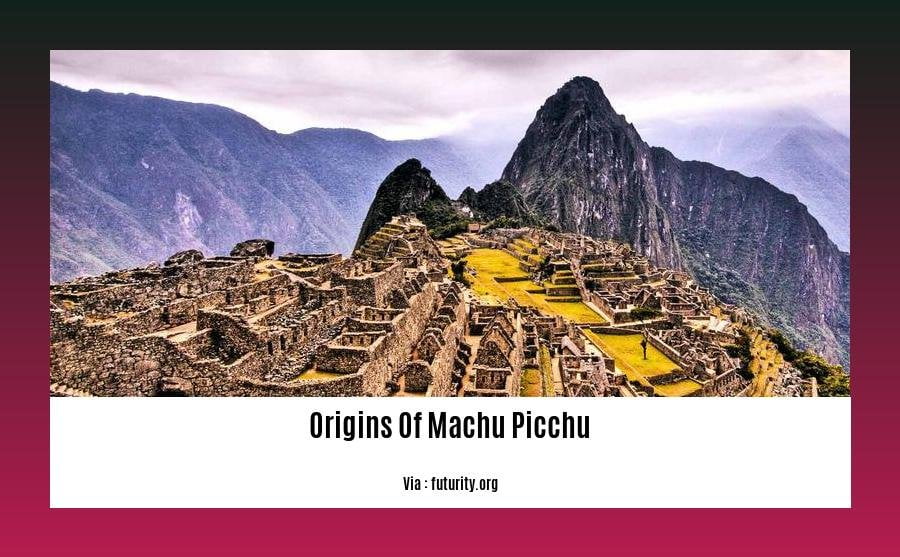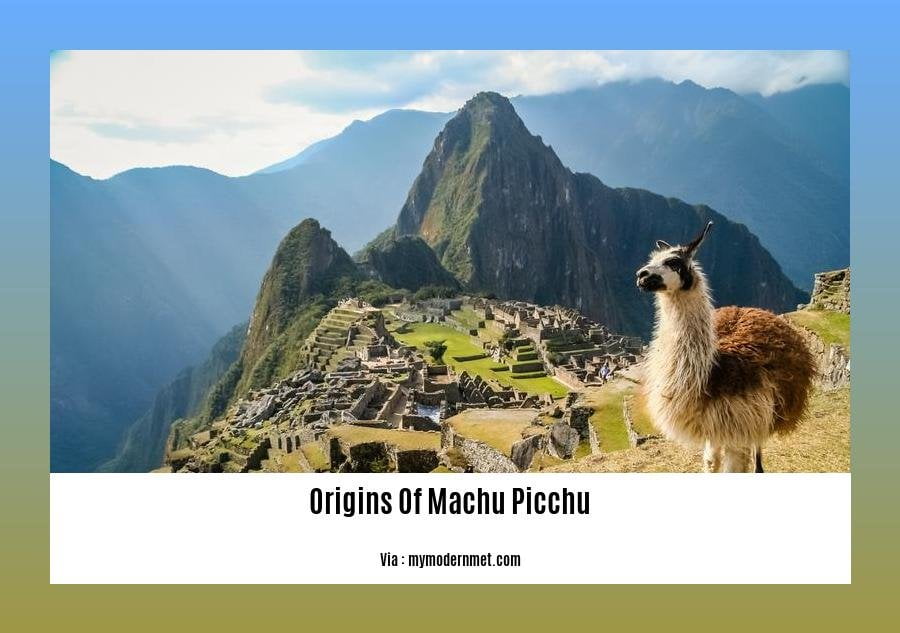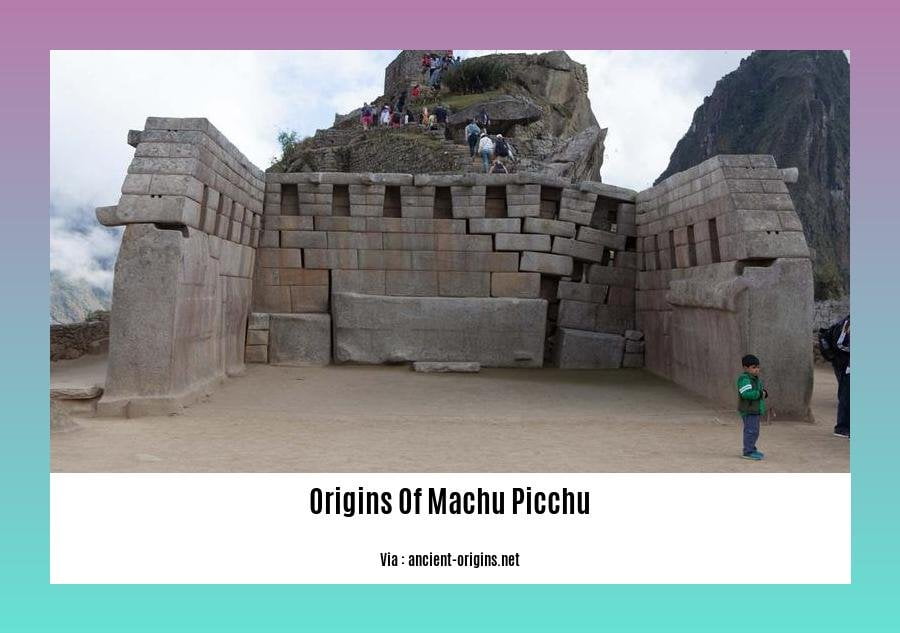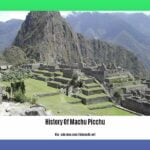Unveiling the Origins of Machu Picchu: An Archaeological Journey Through Time. Join us as we embark on an archaeological adventure to uncover the enigmatic origins of Machu Picchu, the legendary Inca citadel perched high in the Peruvian Andes. Through meticulous excavation and analysis, we will delve into the depths of time, unearthing the secrets that lie beneath the ancient ruins, revealing the cultural practices, historical influences, and architectural ingenuity that shaped the creation of this iconic marvel.
Key Takeaways:
– Machu Picchu was constructed as a royal retreat around 1450 by the Inca emperor Pachacuti.
– It was strategically located in the Andes, overlooking the Urubamba River.
– Machu Picchu was abandoned a century after its construction, possibly due to the Spanish conquest.
Origins of Machu Picchu: An Archaeological Journey Through Time

Machu Picchu, an enigmatic citadel nestled high in the Peruvian Andes, has captivated the world for centuries. Its origins remain shrouded in mystery, but archaeological evidence provides tantalizing clues about its inception and purpose.
The Royal Estate
Around 1450, Pachacutec, the first great ruler of the Inca Empire, embarked on an ambitious construction project. He envisioned a royal estate, a refuge far from the bustling capital of Cusco. Cradled amid towering peaks and overlooking the Urubamba River, Machu Picchu’s origins emerged.
Architectural Ingenuity
Machu Picchu’s architecture showcases the Incas’ exceptional craftsmanship. Terraced fields cascaded down the mountain slopes, providing sustenance for the inhabitants. Intricate stonework adorned palaces, temples, and the iconic Inti Huatana, a sundial that played a pivotal role in Inca astronomy.
Abandoned City
A century after its construction, Machu Picchu was largely abandoned. Reasons for this remain speculative, but scholars suggest political upheaval, disease, or environmental factors could have contributed to its decline. The site was reclaimed by jungle and lost to the world until its rediscovery in 1911.
Archaeological Explorations
Since then, archaeologists have meticulously excavated and studied Machu Picchu. They have unearthed remnants of daily life, including ceramics, textiles, and agricultural tools. These findings have shed light on the Inca culture and the purpose of this enigmatic citadel.
A Symbol of Inca Legacy
Today, Machu Picchu stands as a testament to the architectural brilliance and cultural achievements of the Inca civilization. As we delve into Machu Picchu’s origins, we gain a deeper appreciation for its rich history and the enduring legacy of the Inca Empire.
Uncover the enchanting history of Machu Picchu, an ancient citadel that stands as a testament to the ingenuity and architectural prowess of the Incas.
Explore the History of Machu Picchu in English , gaining insights into the intriguing past of this iconic landmark and its pivotal role in the Inca civilization.
Immerse yourself in the captivating story of Machu Picchu, a tale of mystery, exploration, and the enduring legacy of the Inca Empire.
Architectural Significance

Machu Picchu is renowned for its architectural significance and innovative design principles. It reflects the exceptional craftsmanship and ingenuity of the Inca civilization. The intricate stonework, precise engineering, and harmonious integration with the surrounding landscape showcase the Incas’ architectural prowess.
Design Features
- Terraced Fields: The agricultural terraces at Machu Picchu demonstrate the Incas’ mastery of irrigation and farming techniques.
- Inti Watana Stone: This stone pillar is believed to have been used for astronomical observations, aligning with the sun’s position during solstices.
- Temple of the Sun: This circular structure, with its trapezoidal windows, displays the Inca’s knowledge of geometry and acoustics.
- Stonework: The walls of Machu Picchu are constructed with precision-cut stones, fitted together without the use of mortar.
Architectural Harmony
The structures at Machu Picchu blend seamlessly with the natural environment. The buildings are strategically positioned to maximize sunlight and take advantage of the surrounding peaks and valleys. The architectural design creates a sense of harmony and unity with the landscape, reflecting the Inca’s reverence for nature.
Symbol of Inca Civilization
Machu Picchu stands as a testament to the architectural achievements of the Inca civilization. Its ingenious design, intricate craftsmanship, and strategic location make it a masterpiece of ancient engineering and a symbol of the Inca empire’s glory.
Key Takeaways:
- Machu Picchu showcases the architectural significance of Inca civilization.
- Its terraced fields, precise stonework, and harmony with the landscape reflect the Incas’ ingenuity and craftsmanship.
- The structures blend seamlessly with the natural surroundings, creating a sense of unity and respect for nature.
- Machu Picchu remains a symbol of Inca architectural prowess and an enduring testament to their cultural legacy.
Sources:
- Machu Picchu Architecture
- History and Architecture of Machu Picchu
Purpose and Use of Machu Picchu
Nestled amidst the towering Andean peaks, Machu Picchu stands as a testament to the architectural ingenuity of the Inca civilization. This enigmatic city, shrouded in mystery, has captured the imagination of historians, archaeologists, and travelers for over a century.
Purpose
The purpose of Machu Picchu is still a subject of debate among scholars. Some believe it was an exclusive royal retreat for Inca emperors, a sanctuary for the elite, and possibly a place of pilgrimage. Others suggest it may have served as an astronomical observatory due to its alignment with celestial events.
Use
Machu Picchu’s use can be inferred from the structures found within its walls. The terraces, for instance, were likely used for agriculture, providing food for the inhabitants. The temples and religious buildings indicate its spiritual significance. The intricate water management system suggests a sophisticated understanding of hydraulic engineering.
Key Takeaways:
- Machu Picchu’s purpose remains a mystery, with theories ranging from royal retreat to religious or astronomical center.
- The use of the city is evident in its architectural structures, including terraces for agriculture, temples for worship, and a water system for irrigation.
- Machu Picchu provides valuable insights into the cultural, religious, and engineering achievements of the Inca civilization.
Citations:
- World History Encyclopedia: Machu Picchu
- National Geographic: Machu Picchu
Rediscovery and Tourism
Key Points:
- Rediscovered in 1911: American explorer Hiram Bingham III stumbled upon the lost city of Machu Picchu on July 24, 1911.
- Unveiling the Past: Bingham’s discovery sparked global interest, leading to extensive archaeological excavations that shed light on the city’s history and significance.
- A Tourist Marvel: Today, Machu Picchu is a UNESCO World Heritage Site and one of the most popular tourist destinations in South America, attracting millions of visitors annually.
- Economic Catalyst: Tourism has become a significant economic driver for the region, creating jobs and supporting local businesses.
- Preserving the Legacy: Responsible tourism practices are crucial to preserve the fragile ecosystem and cultural heritage of Machu Picchu for future generations.
Relevant Sources:
- National Geographic: Machu Picchu
- UNESCO: Machu Picchu
FAQ
Q1: When was Machu Picchu built?
A1: Machu Picchu was built around 1450 by order of Pachacutec, the first great ruler of the Inca Empire.
Q2: Why was Machu Picchu built?
A2: Machu Picchu was built as a royal estate for Pachacuti Inca Yupanqui, the first great Inca emperor. It was likely used as a retreat and a place for religious ceremonies.
Q3: Who discovered Machu Picchu?
A3: Machu Picchu was discovered by American explorer Hiram Bingham III in 1911.
Q4: When was Machu Picchu abandoned?
A4: Machu Picchu was abandoned approximately 100 years after its construction, likely around the time of the Spanish conquest in the 1530s.
Q5: Why was Machu Picchu abandoned?
A5: The exact reason why Machu Picchu was abandoned is unknown, but it is likely due to a combination of factors, including the Spanish conquest, disease, and agricultural problems.
- Unlocking Francis Alexander Shields’ Finance Empire: A Comprehensive Biography - July 12, 2025
- Unveiling Francis Alexander Shields: A Business Legacy - July 12, 2025
- Francis Alexander Shields’ Business Career: A Comprehensive Overview - July 12, 2025















